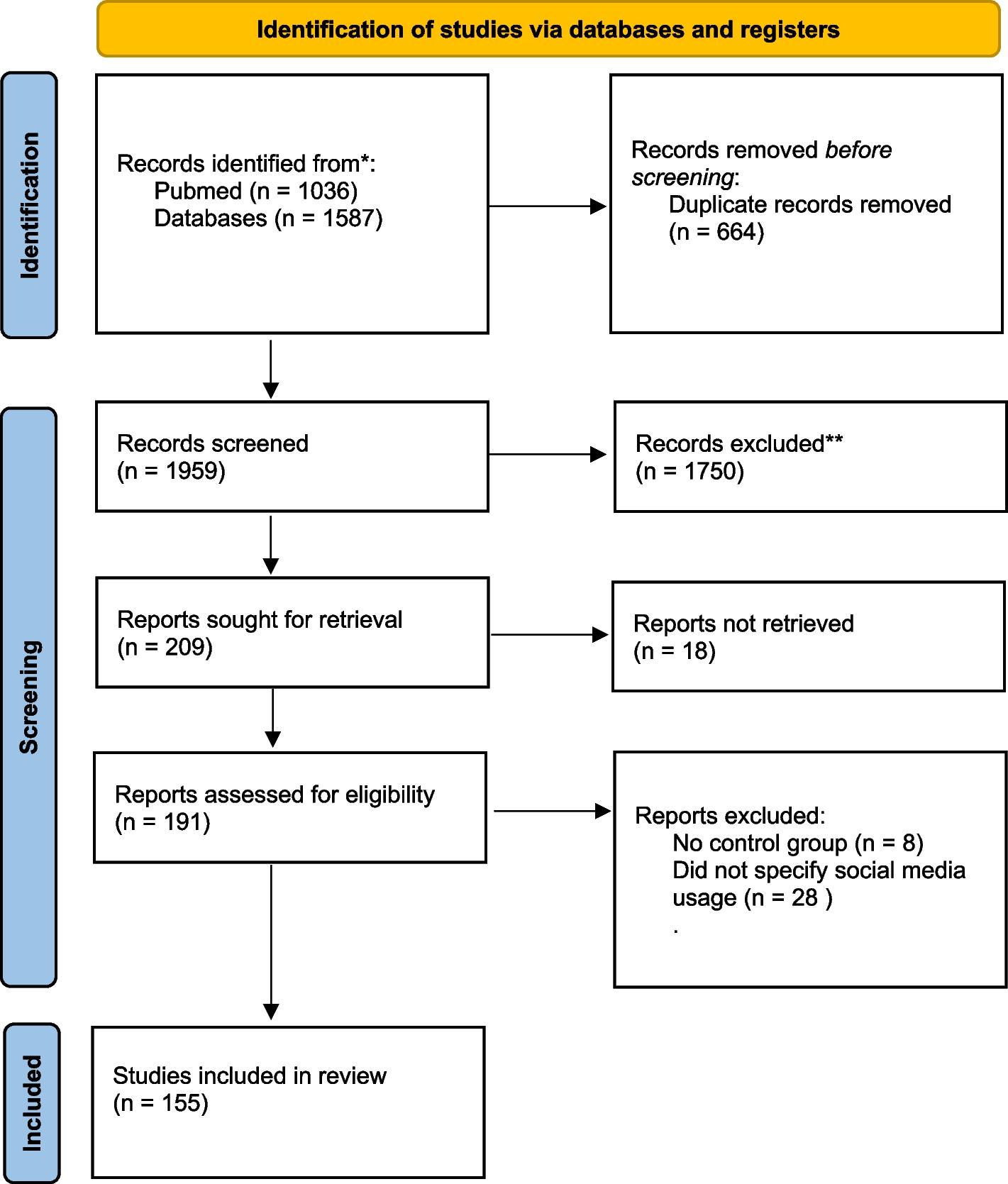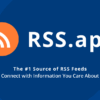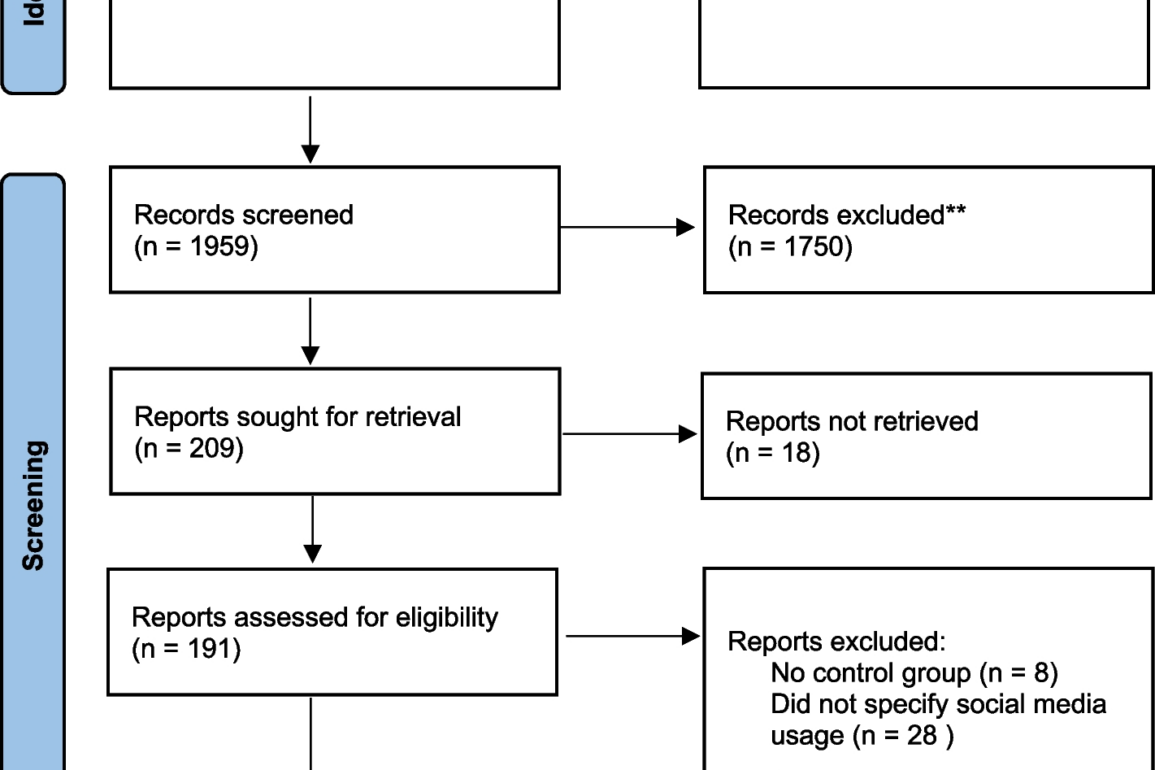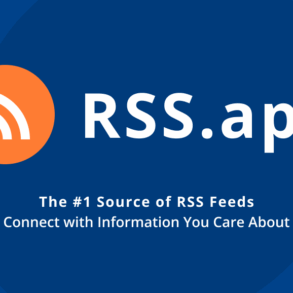
Trait-level analyses of social media usage
Patterns of social media usage in relation to different mentalistic domains
Social media as considered here is not a homogenous construct but a conglomeration of online functionalities that includes and emphasizes different social functions, depending on the nature of the site in question. Such media include, for example, Facebook, Whatsapp, Instagram, TikTok, WeChat, Instagram, Messenger, LinkedIn, Telegram, Snapchat, and Youtube. These platforms are diverse yet all include some elements of social cognition, social interaction, social engagement or social connection. For example, although Reddit and Instagram are both considered as “social media”, the former is more solitary and text-based, and involves asynchronous discussions dedicated to special interest subforums (subreddits) versus the image-driven Instagram, which is more geared toward curation of a self-narrative via videos, “stories”, and images with filters and other imaging-editing tools. Some sites also involve forms of entertainment, considered to elicit passive watching, although in many cases these involve watching other people and engaging socially with them in a detached way (e.g., by imagining their social lives). All such sites are ‘social’ in that they involve one person interacting with another person or their virtual incarnation, such that one or both are affected in some cognitive or affective way. Thus, social media usage patterns can be divided in terms of their correspondence to real-life socio-cognitive traits, and potential psychiatric disorders and traits that may be associated with usage, with particular attention to how different social media sites may affect different mentalistic functions.
We thus considered the following trait-based domains: (1) social monitoring and paranoia, (2) sexual relationships and erotomania, (3) reality perception, reality distortion and psychosis, and (4) dissociation and depersonalization. We also considered these domains, and the disorders associated with them, in the contexts of self-perception and self-embodiment, and self or body image. Each socio-cognitive trait and its corresponding virtual equivalent, as well as relevant pathologies, is discussed in detail below.
Social monitoring and paranoia
Seven papers fit the criteria for social media usage in relation to paranoia or social surveillance. As expected, the currently available data indicate that social media usage may enhance feelings of social monitoring. Four studies indicate that social media usage may contribute or exacerbate feelings of surveillance, even paranoia [13,14,15,16]. Two studies revealed that the asynchronous nature of communicating on social media may lead to hyper-mentalistic behaviours, such as worrying or imagining what the other party is thinking [17] (Schwartz M: The usage of Facebook as it relates to narcissism, self-esteem, and loneliness, unpublished thesis). Lastly, one study found that social media usage was positively associated with public self-consciousness [18], which has been linked to feelings of being watched [19].
Several lines of evidence suggest that social media may exacerbate feeling of social surveillance via its constant status updates and unpredictability of feedback. Thus, for example, young adults have reported curating their social media profiles and privacy settings according to the needs of an imagined audience (“you never really know who’s looking”) [13]. Problematic social media has also been associated with paranoia in a sample of adolescents [16]. Gill [14] interviewed young adults on their social media use, and found that women frequently reported feelings of being watched and judged on social media (e.g., feelings of being “stared at”), as well as reporting implicit expectations that their online content may be screen-saved and criticized. Furthermore, public self-consciousness (i.e., the outward displays of self as a social object) has been shown to be positively associated with a higher frequency of posting photos, replying to comments on photos, and resharing photos on social media, in a sample of South Korean university students [18]. Emotional venting, and viewing profiles of users who were not “friends” on social media, have also been associated with subsequent increases in paranoia [15].
‘Read receipts’, electronic notifications that a sent message has been opened and “read” by the recipient, have been widely adopted across social media platforms. A qualitative study found that university students often worry about what the other person is thinking when their messages are read but not responded to (“I think it makes people insecure… You have time to overthink about that situation… until the person responds”) [17]. One study presented participants with a sample text message conversation and asked them why a message was left on “read” with no response; most participants inferred that the non-response was intentional, and that a non-response constituted a rejection even when no explicit rejection was made (Schwartz M: The usage of Facebook as it relates to narcissism, self-esteem, and loneliness, unpublished thesis). These diverse lines of evidence suggest that the asynchronous and disembodied nature of social media has created a ubiquitous sense of remote surveillance, that may exacerbate feelings of social anxiety and paranoia, via excessive perceived virtual surveillance and social ambiguity.
Sexual relationships and erotomania
Five papers, discussing seven case studies in total, met the criteria for social media usage in relation to erotomaniac delusions (Supplementary Table 1). Two of the five papers observed that the patients with erotomaniac delusions had personal or family-related prior psychiatric histories involved psychotic spectrum disorders [20, 21]. Finally, four of the five papers reported that patients with erotomaniac delusions tended to also experience ideas of reference and magical thinking, mis-interpreting or over-interpreting hidden meanings in their love object’s online posting even when none existed. Taken together, the current data support the idea that social media usage may help to generate or sustain erotomaniac delusions in individuals with psychotic traits, particularly those involving hyper-mentalizing.
How might social media facilitate the development of erotomaniac delusions? Before the advent of online social media, human courtship and sexual relationships were initiated and built via some combination of face-to-face physical interactions with arrangements made by family or friends. The virtualization of social media is expected to alter the nature of such relationships in several important ways, potentially leading to enhanced risks for several forms of pathology.
First, as more relationships are virtualized, the incidence of erotomaniac delusions is expected to increase, as initiations of romantic or sexual encounters can become largely or entirely one-sided and based on illusory interest. Once referred as “psychose passionelle” [22], erotomania is a delusion wherein the individual, usually a young woman, believes that another person, usually of higher social status or unattainable in some other way, is in love with them despite an absence of evidence. Erotomania has thus been considered as an “excessive theory-of-mind” delusion where the individual becomes infatuated with impossible love objects [23], with mis- or over-attributing mental states of reciprocated love to others. Erotomania also commonly co-occurs with other psychotic disorders, including persecutory delusional disorder, schizophrenia [24], paranoid psychosis [25], bipolar disorder, and schizoaffective disorder [26].
Second, social media has removed or reduced physical and temporal barriers on mate seeking, which means that previously unattainable individuals (e.g., Hollywood stars) may appear accessible as prospective mates, since anyone can initiate contact via virtual means. The rise of ‘influencer culture’ on social media may also encourage more intimate experiences of ‘parasocial’ relationships; that is, illusory and one-way relationships where the viewer or social media user perceives the social media personality as a “friend” despite a lack of real-life interactions. In line with this view, exposure to, and interacting with, social media personas increase the strength of perceived parasocial attachment [27,28,29,30] and attraction [31]. These data suggest that even mere exposure to virtual personas can increase feelings of emotional attachment in neurotypical and healthy individuals, with increased exposure potentially leading to elevated risk of triggering forms of erotomania in vulnerable individuals.
Third, the typical patient with erotomania has been described as timid, sensitive, and socially isolated, experiencing difficulties with interpersonal attachments, and with tendencies towards ideas of reference [32]. Erotomania is also a female-biased delusional disorder, with a female to male ratio of about 3:1 [33]. Accordingly, five out of seven published case studies of social media-related erotomania show that the patient was female [20, 34, 35]. The patient is typically socially isolated, using social media as the primary or sole source of social interactions [20, 21]. Consistent across studies, patients also experience delusions of reference and perceived special hidden meanings in their love objects’ social media updates as “evidence” of their illusory love relationships [20, 21, 36]. Under a model of excessive mentalistic virtualization of socio-sexual interactions, high levels of social media usage may facilitate erotomaniac delusions in individuals who are socially isolated, exhibit impaired reality testing, lack real-life intimate relationships, and are prone to positive schizotypal traits such as excessive ideas of reference and magical thinking – all characteristics of the typical erotomania patient as described in the case studies in Supplementary Table 1.
Reality perception, reality distortion and psychosis
Thirteen papers met the screening criteria for social media usage and psychosis. Seven papers report case studies of patients suffering from social media or internet-related paranoia or delusions of persecution [37,38,39,40,41,42,43]. One paper reported a case study of an individual suffering from “hacking” delusion [44], which may be considered as the virtual equivalent of persecutorial delusion where individual privacy is lost. Three papers reported case studies of individuals who experience the delusion of having one’s sense of movements and agency being externalized to an online presence [45,46,47]. One article described a patient suffering from a delusion of online thought broadcasting [48]. Lastly, one paper documented the case study of a patient hearing commanding hallucinations through the internet [49]. Notably, all case studies discussed in the 13 papers have documented psychotic themes where there is a loss of the boundary between the self and non-self, which may be enhanced by the disembodied nature of internet or social media usage.
Reality distortion in psychosis includes magical thinking, ideas of reference (delusions of reference), thought broadcasting, and conspiratorial and persecutorial delusions, among other related phenomena. Increased immersion in virtual social media environments may be conducive to such psychotic cognition by altering reality perception in several ways. First, most social media platforms employ various forms of hidden website trackers that follow, monitor, and analyze users’ behaviors across a variety of websites to generate individualized ads and newsfeed to increase user engagement. The automatic curation of online content tailored to each users’ activity may promote the development of ideas of reference, as content is automatically and spontaneously updated “just-so” to each users’ previous activity [37]. Furthermore, the sense of disembodiment, blurring of self-other and private-public boundaries in online spaces, and lack of physical non-verbal cues may also increase feelings of mistrust, even paranoia, as online communications tend to be more ambiguous than face-to-face ones, and thus are more open to misinterpretation [43].
The increasing deployment of smart algorithms in social media platforms may also increase levels of hyper-mentalizing. For example, Twitter (now ‘X’) algorithms track users’ top-engaged accounts and rank them accordingly, curating the news feed in such a way that the users’ most-engaged account is shown first, which may heighten feelings of surveillance and delusions of thought-broadcasting as the website just “knows” what the user is most interested in. Indeed, paranoia is negatively associated with attitudes toward purchasing online, a finding that may be mediated by general distrust of advertisers’ use of subliminal messages [50]. Over time, the constant exposure to the individualized content may increase feelings of suspiciousness or paranoia that “someone” is watching them, and may serve to reinforce or exacerbate an individual’s underlying psychotic spectrum traits. Numerous case studies of social media or internet-related psychosis have been reported in the literature, that appear to derive in part from these considerations (Supplementary Table 2).
Several common themes link these cases of internet or social media-related psychotic traits. First, several case studies have observed that patients were typically socially isolated and spent time online in lieu of real-life relationships [37, 43, 45]. Second, feelings of surveillance (i.e., being monitored, tracked, followed) or externally controlled (e.g., hacked) were reported in the majority of case studies [38,39,40,41,42, 44, 47, 48]. For example, one case study (of Patient ‘A’) observed that the patient reported that people were following his activities online, and that a popular search engine was tracking his activities, as the name of the search engine shared the first two letters of his first time (“Al in” “Altavista.com”) [39]. Although the patient had cited a bizarre and implausible reason for being tracked online (i.e., name similarity) [39], modern search engines do monitor and curate results based on user activity, which may reinforce ideas of reference in high-risk individuals already predisposed to psychotic traits. Thus, the self-reinforcing nature of internet searches and smart algorithms may strengthen budding delusional beliefs. For example, patient W.L., who had a history of bipolar disorder, was already experiencing intrusive thoughts and feelings of suspiciousness when she started searching for the term “phenylalanine” online. When W.L. came across a webpage on an Aramaic system for divining special meaning from numbers, she interpreted it as secret information about the “Al-Qaeda network” and became paranoid that she was being monitored and tracked [38]. Likewise, patient K.D., who had previously consulted a physician for feelings of suspiciousness, developed the persecutory delusion that a secret organization was after him and his family, citing that the secret organization was behind hidden sections of several international companies’ websites [38]. Given that most websites do contain hidden sections that are not accessible to the general public, the uncertainty between private-public boundaries in online spaces may increase feelings of social surveillance to pathological levels in individuals who are already prone to paranoid ideation, as illustrated in the examples above.
Case reports have also noted that increased exposure to social media may lead to ideas of reference in individuals predisposed to psychosis [43]. In all three case studies reported by Nitzan et al. [43], the patient started experiencing psychotic symptoms, particularly delusions of reference, as they increased their social media usage to supplement the lack of interpersonal intimacy in their lives. In two of the three case reports, the patients started perceiving special hidden meanings in their social media newsfeeds and “friends” online messages with increasing social media use [43]. Given that most social media newsfeeds show users content that they are most “interested” in, the self-reinforcing cycle of smart algorithms may provide positive feedback that strengthens delusions of reference in users predisposed to psychotic-affective traits.
Dissociation and depersonalization
Four papers met the screening criteria for dissociation or depersonalization and social media usage. Two articles indicate that excessive social media or internet use are associated with increased levels of dissociative experiences [51, 52]. One study found that exposure to virtual reality environments can increase subsequent feelings of dissociation [53]. One study also noted that increased virtual social activities (i.e. video game, video meetings) have been positively associated with depersonalization experiences [54]. Given the novelty of virtual realities (i.e. video meetings) replacing in-person social activities, studies on the relationships of social media with dissociation are sparse. However, the available data indicates that increased virtual social interactions in lieu of real-life ones may be associated with increased levels of dissociation and depersonalization.
Dissociation, the experience of disconnections between sense of self, thoughts, memories, and emotions and detachment from the bodily self, personal agency, and objective reality, represents an imagination-based psychological experience that is both a typical experience in everyday life (e.g., in daydreaming, or being so totally immersed in reading a book as to lose track of one’s surroundings), and, in excessive form, a feature of positive symptoms of psychosis [55]. Use of social media is an intrinsically dissociative experience, given that the individual is generally mentally detached from their current physical and bodily surroundings as they focus on the online content at hand. Indeed, several studies have linked dissociation with social media use or other internet-based activities. For example, problematic social media usage and excessive Internet use have been associated with higher levels of dissociative experiences [51, 52]. Exposure to virtual reality environments has been found to increase subsequent feelings of dissociation, as well as diminish feelings of real-life presence in objective reality, in a sample of healthy college students [53]. Moreover, increased participation in other virtual activities such as video gaming and virtual meetings has also been positively associated with depersonalization experiences [54]. Given that social media usage induces dissociative symptoms in healthy individuals, excessive social media usage may be associated with more pronounced symptoms of dissociation, involving aspects of psychosis, among individuals predisposed to psychotic traits and socially isolated from the ‘real-life’ social world.
Disorder-level analysis of social media usage and social brain disorders
We discuss a broad range of disorders, and it is important to bear in mind that, despite their DSM-based definitions, each of them is diverse in the symptoms displayed by each individual. Such variability emphasizes the need to avoid stereotyping, and to consider psychiatric disorders as due to many genetic, environmental and interactive causes.
Psychotic spectrum disorders and general social media usage
Psychosis involves reality distortions: the loss of abilities to differentiate what is real and what is not. Given that the psychotic spectrum encapsulates a wide range of conditions, we summarize each condition’s relationship to this spectrum, and to social media usage, in detail below.
Schizotypy and schizophrenia
Schizophrenia involves some combination of positive (psychotic), disorganized (cognitive), and negative (social withdrawal, anhedonia, and other traits losses or reductions) symptoms [56]. Schizotypal personality disorder, which involves similar but less pronounced symptoms, is characterized by ideas of reference, magical thinking, odd thinking or speech, unusual experiences, bodily illusions, suspiciousness or paranoid ideation, constricted or inappropriate affect, and social anxiety that does not diminish with familiarity [57]. Given that one aspect of positive schizotypal traits is social anxiety, individuals higher in schizotypal traits might be expected to exhibit greater social media use, in lieu of in-person social interactions, given its more impersonal nature.
Of the five studies addressing schizotypal personality and social media usage, three found positive relationships between schizotypal traits and online social activities [58,59,60] (Table 3). For example, two studies have found positive relationships of schizotypal traits with chatroom participation [58] or Facebook usage [59]. One study has detected a positive association between problematic internet usage and psychotic-like experiences [60]. Likewise, internet addiction symptoms have been linked to disorganized schizotypy [59].
Two other studies found more or less indirect evidence between schizotypy and social media usage. For example, one study has found that increased text messaging is associated with increased suspiciousness (Hogg JLC: Impact of personality on communication: an MMPI-2 study of African American college students and their choice in the digital communications age, unpublished). Another study has found that higher immersive tendencies may be associated with greater problematic Facebook usage, problematic internet behaviours, and high schizotypal scores [61]; however, direct relationships between problematic Facebook usage and schizotypal traits were not investigated.
Of the papers that investigated the relationships between social media usage and schizotypal traits or psychosis, one found increased social media usage linked to prediction of positive psychotic-like experiences in a sample of non-clinical individuals [62], whereas the other found that adults diagnosed with psychosis used social media less frequently compared to a control group [15].
Overall, as summarized in Table 3, current data suggest that schizotypal traits may be associated with social media usage. For example, Mittal et al. [58] found that adolescents diagnosed with Schizotypal Personality Disorder spent more time in online chat rooms compared to controls, and severity of schizotypal personality disorder symptoms were also positively correlated with cooperative online gaming, internet chat room, and email usage. Similarly, in a sample of young adult with psychotic-like experiences, problematic internet usage and reality substitution (the extent to which the individual perceives the online environment as another “reality” and immerses themselves in it) showed longitudinal decline in the group whose psychotic-like experiences improved or remained steady; in contrast, levels of problematic internet usage and reality substitution were constant in the group whose psychotic-like experiences increased [60]. Likewise, Massaro et al. [59] reported that schizotypy total scores predicted internet addiction behavior and frequency of Facebook use in a sample of undergraduate university students. In addition, Hogg (Hogg JLC: Impact of personality on communication: an MMPI-2 study of African American college students and their choice in the digital communications age, unpublished) found that college students who spent ‘excessive’ time instant messaging endorsed higher levels of suspiciousness, fearfulness, and dissociation from reality – all of which are common features of positive schizotypy.
Notably, Hogg (Hogg JLC: Impact of personality on communication: an MMPI-2 study of African American college students and their choice in the digital communications age, unpublished) found, among healthy college students, that spending 11-15 h a week on instant messaging and social media was associated with the highest level of psychological well-being. Risk to well-being increased when instant messaging dropped below or increased beyond this level. Furthermore, psychopathological symptoms (e.g., suspiciousness, rigidness in thought, peculiar perceptions, and dissociation from reality) were most strongly associated with instant messaging when it exceeded 26 h a week (Hogg JLC: Impact of personality on communication: an MMPI-2 study of African American college students and their choice in the digital communications age, unpublished). Finally, Tamás et al. [61] reported that higher scores on the Involvement scale of the Immersive Tendencies Questionnaire were associated with greater problematic Facebook usage, problematic internet behaviours, and higher schizotypy scores. The Involvement scale measures the degree to which individuals experience a sense of passive immersion while reading a book or playing computer games [61]. Given the above findings, positive schizotypal traits may be associated with greater social media usage due in part to the former’s dissociative nature.
These findings suggest that positive schizotypy may be associated with greater social media usage, with the effect moderated by different levels of immersion in social media. However, given that only one out of three available studies directly tested the relationships between positive schizotypy and social media (i.e., Facebook) usage [59], further research is needed.
Two studies investigated the relationship of social media usage among individuals with psychotic-like experiences or schizophrenia (Table 4 ). One study found that number of hours of social media use per day contributed significantly to the prediction of positive psychotic-like experiences, in a sample of non-clinical undergraduate students [62]. By contrast, adults diagnosed with psychosis used social media less, compared to the control group [15]. The same study also found that the following social media activities predicted increases in paranoia: 1) posting about feeling and emotional venting, 2) viewing profiles of people who were not “friends” on social media, (3) commenting on other peoples’ status updates. Although empirical studies on the relationships between social media usage and paranoia in patients with psychosis are thus lacking, current data suggest that social media activity, particularly those that imbue a virtual feeling of surveillance, may underlie decreased social media activity in individuals with clinical diagnosis of psychosis. By contrast, individuals with positive schizotypal traits, particularly those high in social anxiety and disorganized faculties, may gravitate toward greater social media or usage of virtual social media, possibly due to its relatively anonymous, distancing, and immersive nature of social engagements (Table 3).
Bipolar disorder
Bipolar disorders involve mania, hypomania, depression and mixed states, with varying degrees of severity, and forms of psychosis in Bipolar I [63]. Three studies met the search criteria for social media usage in individuals with bipolar spectrum disorders. Out of the three studies, one had found a positive relationship between clinical symptoms of bipolar-mania and Facebook usage [64]. Rydahl et al. [65] found that individuals with bipolar disorder were more likely to report social media “regret” behaviours compared to controls (e.g., “Writing private messages”, “Sending photos privately” and “Sending videos privately”), but direct relationships between bipolar disorder and social media usage were not investigated. Lastly, Martini et al. [66] found that patients with bipolar I or bipolar II disorder exhibited less familiarity with social networking sites and had fewer Facebook contacts than controls.
Given that mania episodes in bipolar I disorder are characterized by some hyper-mentalistic (e.g., paranoia, feeling of surveillance, delusions of reference) and hyper-social behaviors (e.g., sexual promiscuity, gregariousness), social media usage is expected to increase during manic phases of bipolar I disorder. As elaborated below, available studies suggest that increased manic symptoms in bipolar disorder may be associated with greater active social media usage [64] or other use of online media, in a way to mirror real-life manic behaviours [65]. However, Martini et al. [66] found that patients with bipolar I and bipolar II had fewer Facebook friends than controls. Given the few studies available on social media usage in bipolar spectrum disorder, no definite conclusions can be drawn.
Narcissistic personality disorder
Narcissistic personality disorder (NPD) is characterized by grandiose self-perception, need for admiration, interpersonally exploitative behaviors, and lack of empathy [67]. Narcissistic personality disorder is typically characterized by fantasies of grandeur, or the idea that the self is exaggerated to be unique and superior, although it can also involve forms of psychological vulnerability expressed in social hypersensitivity and defensiveness [68]. NPD is notably comorbid with several other psychotic/affective spectrum conditions, including paranoid personality disorder [69, 70], major depression [71, 72], and bipolar disorder [72,73,74].
A total of 70 papers met the screening criteria for social media usage in narcissistic personality disorder. The majority of these papers (sixty) show that narcissistic traits are positively associated with greater social media usage [75,76,77,78,79,80,81,82,83,84,85,86,87,88,89,90,91,92,93], greater social media usage for romantic purposes [94], greater production of content on social media [95], greater frequency of selfie-posting [96,97,98,99,100,101,102,103,104,105], selfie-editing [106], selfie-liking [107], Facebook friends [108,109,110] (Kojouri C: Using Facebook to self-enhance: narcissism and psychological outcomes, unpublished) and status updates [111,112,113], greater self-promotional content on social media [114, 115], problematic or addictive social media usage [116,117,118,119,120], greater self-promoting behaviors on Facebook [121], more interacting with Facebook photos [122], Facebook addiction [87, 123], internet addiction [124], greater Facebook intensity and personal involvement (i.e. “I want to express and present myself” [125], Facebook addiction symptoms [123, 126,127,128], risk factors for Facebook addiction [129], greater motivation of using social media for self-promotional purposes [130], and greater importance and involvement placed on feedback received online [131, 132].
In contrast to the findings above, seven studies reported that narcissistic traits were not associated with increased social media usage [133,134,135,136] (Schwartz M: The usage of Facebook as it relates to narcissism, self-esteem, and loneliness, unpublished thesis), increased numbers of Instagram followers [137], or number of selfies posted [138]. Pathological narcissism was also found not to be a significant predicator of selfie-engagement [139]. Three studies yielded mixed findings on narcissism and social media usage. For example, Eşkisu et al. [140] found that narcissism scores did not differ between those who with or without a Facebook account. However, the same study also found that narcissism scores were significantly higher for individuals who spent more than 3 h on Facebook and have more than 300 Facebook friends, compared to those who only use Facebook for less than one hour/day and had 151-300 friends. Lastly, Martin [141] found that higher vanity scores were associated with posting more athletic photos on Facebook in both sexes, but only men scoring low in vanity posted more attractive photos. The findings above suggest that, as social media platforms have become more mainstream, the relationships between social media usage and narcissism may emerge predominantly in the upper percentile of usage.
Central characteristics of NPD also include exhibitionism, entitlement, and excessive need for admiration [67], all of which are consistent with the mentalistic trait of social surveillance. Given that narcissism is characterized by excessive need for admiration and self-aggrandizing behaviors, higher narcissistic traits are expected to be associated with greater social media usage, as well as self-promotional behaviors, an expectation that is borne out by the reports in Supplementary Table 3.
In accordance with the attention-seeking behaviours of real-life narcissism, narcissism-exhibitionism is positively associated with frequency of Twitter usage, Facebook friends, and greater expression of emotions on social media [88]. Initial levels of problematic internet use predict subsequent levels of narcissism four months later, but only for those who used primarily visual-based forms of social media such as Instagram [119]. Individuals scoring higher on vanity also posted more athletic photos on Facebook [141]. Individuals with higher narcissistic traits were also more involved in feedback (e.g., comments and likes) received on their selfies, more observant of selfies that other people have posted, but not increased likelihood of providing feedback on other peoples’ selfies [132]. Individuals with higher narcissistic traits also regard self-posting as more positive and report higher motivation for posting selfies in the future [132]. Furthermore, social media usage is positively associated with narcissism and alexithymia, and negatively associated with empathy [89]. Taken together, these lines of evidence are consistent with the narcissistic real-life behaviours of being especially attuned to illusory social gaze, particularly involving admiration.
The findings noted above are consistent with reports that individuals high in narcissism tend to be more motivated to seek out situations of positive self-attention, such as gazing at oneself in the mirror, and increased preference of watching oneself on videotapes rather than watching videotapes of others [142]. Indeed, the top motive for taking selfies in a sample of undergraduate students were for narcissistic reasons (e.g., “I think I am attractive and have no problem sharing that”) [104], and for attention-seeking [105]. Grandiose narcissism has also been associated with frequencies of selfie-taking and selfie-posting, as well as experiencing more positive affect when taking selfies [99]. Considered together, the above lines of evidence indicate that the narcissistic pattern of social media usage is consistent with the real-life behaviours of the narcissistic personality – that is, that of the overinflated self-perception.
Although many articles have observed a consistent pattern of higher social media usage in narcissistic individuals, some findings observed no statistically significant relationships between the two [133,134,135,136]. Although some studies have found no significant relationships between narcissism and greater social media usage, the general pattern of use appears to be largely consistent with the selfie-oriented behaviors of real-life narcissism. For example, although Barry et al. [138] found no significant correlation between narcissism and total number of selfies, the same study also observed that vulnerable narcissism was positively associated with a higher proportion of posts that were ‘appearance selfies’ (pictures just of oneself). Conversely, grandiose narcissism was negatively associated with proportion of posts that were ‘affiliation selfies’ (i.e., selfies with other people) [138] – both of which are consistent with prior findings that hypersensitive (i.e. vulnerable) narcissism is positively associated with greater levels of self-objectification [143] and general narcissism with greater need to be at center of attention [144]. Interestingly, although Scott et al., [145] found no significant associations between narcissism and selfies, narcissism predicted likelihood of posting photos in the “pet” category. This finding is also consistent with prior observation that grandiose narcissism is associated with stronger attachment to “traditional” pets like dogs and cats [146]. Other studies have found no relationships between narcissism and number of Instagram followers [137], narcissism to frequency of Facebook checking or Facebook updates [140], or differences in narcissism between individuals who has a Facebook account versus those who don’t [140]. However, in the same study, Eskisu et al. [140] observed that narcissism scores were significantly higher for participants who spent more than three hours a day on Facebook vs. participants who spent less than an hour and had more than 300 Facebook friends versus those who had 151-300 friends [140]. Taken together, the current data suggest that the narcissistic pattern of social media usage largely mirror real-life narcissistic behaviours.
Finally, as summarized in Supplementary Table 3, selfie-taking and status updates are two of the main primary social media activities that have been consistently linked to higher narcissism across studies, demonstrating the self-oriented and performative nature of mainstream social media platforms.
Individuals high in narcissistic traits may also be attracted to social media platforms, as they allow for a large network of loose and impersonal relationships as well as various tools for self-enhancement [114]. For example, scores on the Grandiose-Exhibitionism dimension of narcissism predict self-promoting Facebook behaviors, Facebook friends count, and frequency of accepting strangers as Facebook friends [121], as well as placing greater importance on receiving responses online and looking popular on social media [131]. Grandiose narcissism has also been positively related to time spent on social media, frequency of status updates, number of friends/followers, and frequency of selfies posted on social media [81]. Facebook users were more likely to be narcissistic and extraverted than non-Facebook users [93]. As observed previously by Carpenter [121], patterns of social media usage in narcissism appear to represent “extensive self-presentation to as large as an audience as possible”, which is consistent with the current data showing that individuals with narcissism tend to use social media for self-promotional purposes (Supplementary Table 3). However, Frederick and Zhang [136] observed no significant relationships between narcissism and social media usage. Boursier et al., [139] has also found that pathological narcissism was not a significant predicator for selfie-engagement; rather, selfie-engagement predicted by body surveillance and positive selfie-expectancies about selfie-taking.
Borderline personality disorder
Borderline personality disorder is characterized by pervasive pattern of instability of interpersonal relationships, mood swings, labile affect, impulsivity, self-harm or suicidal behaviors, chronic feelings of emptiness, dissociative symptoms, and transient stress-related paranoia [147]. Borderline personality disorder frequently involves positive psychotic symptoms [148, 149]. Accordingly, by the hypotheses evaluated here, borderline personality disorder should be associated with increased social media usage.
Only two papers met the criteria for social media usage in borderline personality disorder.
Higher borderline personality disorder traits have thus been associated with greater frequency of posting on social media, greater self-reports of regret after posting on social media, greater likelihood of editing or deleting posts after posting, more frequency friending and unfriending behaviors on social media [150]. Borderline personality traits are also associated with increased cyberbullying behaviors in adolescents, particularly malicious social gossip [151], the production of which requires substantial mentalizing skills (e.g., social network monitoring, reputation tracking) [152].
Histrionic personality disorder
Histrionic personality disorder is characterized by excessive attention-seeking behavior, suggestibility, theatricality, being uncomfortable in situations when they are not the center of attention, and considering relationships to be more intimate than they really are [153]. In a sample of 26 patients with recent-onset bipolar spectrum disorder, histrionic personality disorder was found to be the top co-occurring personality disorder [154].
Three papers meet the criteria for histrionic personality disorder and social media usage.
Considering that most social media encourage self-displays (i.e., status updates, selfies), excessive theatricality and attention-seeking behaviors in individuals with histrionic personality disorder should be associated with greater social media usage, as well as greater self-display behaviors such as selfie-posting. Accordingly, histrionic personality traits have been associated with greater social media usage, addictive use of social media, and increased selfie-sharing [155]. In a sample of adolescents aged 14-18 years old, social media addiction has also been positively associated with histrionic personality belief (e.g., “I should be at the center of attention.“) and narcissistic personality beliefs (e.g., “Other people should satisfy my needs”) in both sexes [156]. Similarly, histrionic traits predicted number of selfies posted online, but in men only [157]. The currently available data thus supports the prediction of higher mentalistic traits (i.e., self-display to a virtual audience) in that histrionic personality disorder is associated with greater social media usage. However, given that there are only three available studies on social media usage in histrionic personality disorder, additional studies are needed.
Body perceptual disorders: body dysmorphic disorder and anorexia
Body dysmorphic disorder (BDD) involves pathological preoccupation with perceived negative aspects of one’s bodily appearance, and anorexia is an eating disorder that involves extreme fear of gaining weight, coupled with highly altered perception of overall body weight and image [158, 159]. Thirty-two papers met the criteria for social media usage in individuals with body dysmorphia disorder or anorexia. Of these, 17 studies found that higher social media usage was associated with increased body or weight dissatisfaction [160,161,162,163,164,165,166,167,168], internalization of the thin-ideal [169, 170], eating disorder symptoms [171,172,173,174], dysfunctional eating patterns [175]. Accordingly, Smith et al. [176] found that maladaptive Facebook usage predicted increases in over-eating episodes four weeks later. Five studies reported that online physical appearance comparison was associated with greater disordered eating [177], greater body dissatisfaction [178], drive for thinness [179] or restrained eating via body shame [180].
Three studies found that image-based social media activities may be positively associated with eating disorder symptoms [181,182,183]. In addition to image-based activities, receiving extremely negative feedback to one’s online status updates has been associated with subsequent increases in disordered eating concerns [184]. Taken together, all four papers indicate that increased engagement with social media content can be linked with greater body dissatisfaction and disordered eating symptoms.
In contrast to these results, two studies found no association between social media usage to body dissatisfaction or body image issues [185, 186], and four studies reported mixed findings on the role of social media usage and eating disorder symptoms. For example, Kim and Chock [187] found that viewing and commenting on online peers’ profiles, but not time spent on social media, were associated with increased body image concerns [187]. Similarly, Cohen et al. [188] found that it was not time spent on social media but following “health and fitness” Instagram accounts that was associated with drive for thinness. Tiggemann and Slater [189] found that number of Facebook friends, but not Facebook usage, prospectively predicted greater drive for thinness in a sample of adolescent girls. Cohen et al., [190] found that it was greater selfie investment, not but general social media usage, that was associated with increased body dissatisfaction and bulimia symptoms. Considered together, the current data suggest that it may not be general social media usage per se that is associated with increased symptoms of body dysmorphia or eating disorder symptoms, but a more specific factor, active online physical appearance comparison, that may instead be driving the links between social media usage and body image concerns.
Relationships of social media usage with body image disorders have been well documented in the literature [191]. However, how social media usage may be associated with body dysmorphia and anorexia as psychotic spectrum conditions has yet to be systematically explored. Both BDD and anorexia are characterized by extreme distortions in body self-image. Historically considered as prodromal to, or a variant of, schizophrenia [192,193,194,195], BDD is characterized in particular by excessive occupation with a slight or imagined physical flaw; consequently, the individual may engage in compulsive grooming or reassurance-seeking behaviors as to correct or hide the perceived flaw.
In contrast to individuals with BDD, individuals with anorexia perceives themselves to be excessively overweight, despite evidence to the contrary, and may restrict eating and compulsively exercise excessively to mitigate the self-perceived weight gain. As in BDD (Walker M:Associations between Facebook use and disordered eating in College Women, unpublished), individuals with anorexia also engage in excessive or compulsive body-checking behaviors such as examining their body or body parts in the mirror, checking if their thighs touch, or pinching the stomach to see if it is ‘excessively’ fat [196, 197].
Both BDD and anorexia involve several psychotic spectrum traits. For example, BDD is often characterized by ideas or delusions of reference, such that individuals with this condition are convinced that other people are mocking or noticing their physical flaws [198, 199], experiencing such distress that they may become housebound to avoid being seen [199, 200]. Schizophrenia also shows significant positive genetic correlations with anorexia and other eating disorders [201], indicating a shared genetic based, and BDD exhibits both delusional (psychotic) and somatic presentations, both with high frequencies [202].
Given that both BDD and anorexia are characterized by perturbations to body perception, increased social media usage may promote the expression of BDD and anorexia, as most social media platforms are image-based and encourage the use of multiple photo-editing tools that can be used to create unrealistic expectations of the statistically “normal” body proportions, as individuals compare their bodies to curated images seen on social media. In addition, individuals with BDD or anorexia also engage in compulsive and excessive mirror-checking as part of their body perceptual disorders; as such, given that most social media platforms are image-centric and “reflect” back its users visually based content, BDD, body dysmorphic traits and anorexia should also be positively associated with greater social media usage as virtual extensions of mirror-checking behaviors.
As described in Table 5, three out of four studies provide evidence that body dysmorphic traits may be associated with greater social media usage [203,204,205]. For example, Alsaidan et al., [203] found that body dysmorphic disorder was associated with greater time spent on Instagram and Snapchat, both image-based platforms with a wide plethora of picture and video-editing tools. Accordingly, Griffiths et al., [204] has found that muscularity dissatisfaction and eating disorder symptoms were stronger for image-centric platforms (e.g., Instagram) than for non-image-based platforms (e.g., WordPress). Finally, social media addiction symptoms have been positively associated with muscle dysmorphia-related symptoms, eating disorder-related symptoms, psychopathological distress, and problematic alcohol use [205]. While one study did not find statistically significant relationships between Instagram use and body dysmorphic concerns [206], this study did identify an indirect connection between Instagram use and dysmorphic concerns through the concepts of ‘ideas of reference about laughing and commenting’ and ‘appearance-related comparisons, both of which involve mentalistic faculties of imaginary social surveillance and the illusory social gaze.
As summarized in Supplementary Table 4, increased social media usage has also been associated with increased eating disorder symptoms [171,172,173,174], greater body dissatisfaction [162, 166], weight and appearance dissatisfaction [164], preoccupation with body and food intake [175], internalization of the thin ideal [169], and dieting behavior [170]. Furthermore, compared to Facebook non-users, Facebook users score higher on the Internalization of thin idea, a body surveillance based drive for thinness [165].
Increased exposure to particularly image-centric social media platforms may be associated with greater body dissatisfaction and thus with eating pathology. For example, Cohen et al. [188] found that Instagram users tend to score higher on body surveillance than non-Instagram users, and greater interaction with image-centric content on Facebook (e.g., updating one’s profile photo and viewing other peoples’ photos) were associated with increased body surveillance. Accordingly, Cohen et al., [190] observed that greater selfie investment (i.e. effort in selecting selfies to post on social media), but not general social media usage, is associated with increased body dissatisfaction and bulimia symptoms. In a sample of adolescents, Wilksch et al., [167] reported that number of social media accounts was positively associated with disordered eating cognition (i.e. concern about weight, shape or eating) and behaviors (i.e. skipping meals). Increased daily time spent on using Instagram and Snapchat were also associated with greater disordered eating behaviours, but only in girls [167]. Facebook users reported significantly lower body satisfaction than non-users [161] and increased emotional connection and integration of Facebook into one’s life was associated with increased online physical appearance comparison, which in turn has been linked with greater levels of disordered eating [113]. Furthermore, viewing idealized and edited Instagram images has been associated with greater body dissatisfaction [181]. Instagram photo-based activities positively predicted both drive for thinness and body dissatisfaction through the mediating variable of appearance-related comparisons [160]. The frequency of Facebook-photo related activities was also positively correlated with internalization of the thin ideal, self-objectification, and drive for thinness, and negatively correlated with weight satisfaction [163].
Tiggemann and Slater [189] found that numbers of Facebook friends, but not Facebook usage, prospectively predicted greater drive for thinness in a sample of adolescent girls, suggesting that it may be the excessive virtual body comparison, but not general social media use, that is driving symptoms of eating pathology. Indeed, among Facebook users, number of Facebook friends was significantly correlated with internalization of thinness ideal, body surveillance, and drive for thinness scores [165].
Kim and Chock [187] reported that it was viewing and commenting on peers’ profiles, but not time spent on social media, that was associated with greater drive for thinness in a sample of young adults. Likewise, Cohen et al., [190] found that greater selfie investment (i.e. effort in selecting selfies to post online), but not general social media usage, was associated with increased body dissatisfaction and bulimia symptoms in women. Moreover, Instagram photo-based activities positively predicted both drive for thinness and body dissatisfaction through the mediating variable of appearance-related comparisons [160]. Indeed, frequency of comparing one’s physical appearance to people followed on social media was associated with greater body dissatisfaction and increased drive for thinness [179]. Notably, one study found that discrepancies between women’s perceived actual thinness and what they perceived to be the thinness ideal of women viewed on social networking sites were associated with the greatest level of body dissatisfaction [178]; in other words, women were more like to experience body dissatisfaction when they perceive that other women on social media held a thinness ideal that was considerably different from their actual body shape. In comparison, discrepancies between women’s actual thinness level and what they perceive their real-life female peers held as “ideal” was still associated with body dissatisfaction, but less strongly so [178]. Accordingly, Yao et al., [180] found that body image comparison on social media was positively associated with restrained eating, which was mediated by body shame. In a sample of female undergraduate students, frequency of Facebook usage was positively associated with body dissatisfaction and drive for thinness (which is mediated by both general appearance comparison), as well as with comparison to friends and distant friends, and upward comparison to distant peers and celebrities on social media [168]. In addition, Lonergan et al. [207] found that both avoidance of posting selfies and photo manipulation were associated with greater adjusted odds of meeting criteria for clinical or subclinical anorexia [207]. The same study has also found that online selfie-posting was unrelated to both eating disorder symptom severity and body dissatisfaction. In contrast, Butkowski et al. [185] reported that frequency of Instagram use was not associated with greater body dissatisfaction or drive for thinness. Finally, in a recent meta-analysis, Ioannidis et al. [208] demonstrated that eating disorders, drive for thinness, and dietary restraint were all associated with increased and ‘problematic’ internet use. Taken together, this evidence suggests that social media use may mediate prevalence or severity of eating disorders by promoting an overly idealized but unrealistic points of comparison for its users, particularly those who may already be struggling with self-identities.
As summarized in Supplementary Table 4, many studies have observed a pattern of greater image-based activities and social media usage and increased disordered eating symptoms and body image distortions. For example, young adults who received extremely negative comments in response to personally revealing status updates were more likely to report disordered eating four weeks later [184]. Greater Instagram use has been associated with greater self-objectification; in particular, more frequently viewing of “fitspiration” images on Instagram is associated with greater body image concerns [209]. Selfie-photo modification is also positively associated with rumination about weight, eating, and shape, which in turn has a positive association with disordered eating [210]. Mclean et al. [182] found that girls who regularly share selfies on social media, compared to those who don’t, were more likely to report body dissatisfaction, greater internalization thinness ideal, as well as increased body-related and eating concerns. Likewise, women who post fitspiration images, relative to women who post travel images on Instagram, scored higher on drive for thinness, bulimia symptoms, drive for muscularity and compulsive exercise; furthermore, approximately twice as many women in the fitspiration group were more likely to be at risk for an eating disorder diagnosis than the travel image group [183]. Maladaptive Facebook usage (i.e., negative self-referential activity: e.g., “Reading the status updates of others tends to make me feel down on myself”) predicted increases in bulimic symptoms and number of over-eating episodes four weeks later [176]. By contrast, one study found no significant association. of social media usage with eating and body image problems in a sample of in a sample of high school students [186]. Considered together, the above studies provide evidence that greater social media usage, particularly those involving visual self-presentation (i.e. viewing selfies or “Fitspiration” images) and attendance to social feedback, are associated with greater eating disorder symptoms.
Autism spectrum disorders and social media use
Autism is a neurodevelopmental condition characterized by decreased mentalistic cognition [211].
Although considered as a single condition, it has many genetic and environmental causes, and it is notably diverse as regards the sensory, intellectual, cognitive and affective traits displayed by individuals. As noted above, autistic traits are predicted to be associated with decreased social media usage, as they involve reduced social interests and social interactions [212, 213]. Furthermore, when individuals with autistic traits do use social media, it is predicted to be mainly in the context of non-social (i.e., mechanistic) purposes, such as sharing factual information on topics of special interests.
Nine papers met the search criteria for social media usage in autism spectrum disorders. As summarized in Table 6, seven of the nine available studies indicated that individuals with autism tend to use social media less compared to controls. For example, Mazurek et al., [214] found that compared to youths (age 13–17 years old) diagnosed with other disabilities (speech/language impairments, learning disabilities, or intellectual disabilities), youths with autism spent the highest amount of time (as reported by their parents) on non-social electronic media (e.g., TV, videos), despite being the group with the highest rate of having a computer at home. Furthermore, approximately twice as many youths with ASD did not use e-mail or chatrooms, compared to speech/language impairment and learning disability groups [214], which suggests it is not learning or speech impairments that lead to decreased social media usage, but reduced social interest. Likewise, MacMullin et al., [215] found that individuals with autism, compared to neurotypical individuals, spent less time using electronics for social activities (e.g., social media, talking or texting on a cellphone, instant messaging, using chatrooms, and emails) but more time using the Internet, as well as using the Internet on general non-social activities such as creating documents or editing photos. Similarly, Suzuki et al., [216] found that higher autistic traits correlated with decreased friends and participation in chat groups on the messaging app “LINE” and Instagram use, and Begara Iglesias et al., [217] found that 96% of neurotypical individuals and 82% individuals with intellectual disability used social media, but only 65% of individuals with ASD did so. Individuals with ASD were less likely to use WhatsApp and join fewer Whatsapp groups compared to neurotypical individuals [217] and were also less likely to use electronics (e.g., tablets, phones) to talk with friends relative to neurotypical individuals [217]. Compared to neurotypical children, children with ASD spent less time using social media and more time playing video games, playing video games alone, and were less likely to play socially collaborative video games or play video games with other people [218]. Moreover, boys with ASD also used computer-mediated communication (e.g., emails, text messaging, messaging apps, social media sites) less frequently relative to neurotypical controls [219].
As consistent with ‘real-life’ behaviors (where individuals with autism tend engage in decreased social interactions or less socially motivated), individuals with autism preferred to use phones for games rather than to contact intimate others [220]. Notably, although Alhujaili et al. [221] found no significant differences in average time spent on social media daily between an ASD group and a non-ASD control group, 35% of adolescents with ASD spent more than five hours per day on social media, compared to 18% of non-ASD adolescents. However, the same study also found that individuals with autism were more likely to report using social media for entertainment purposes than social interactions [221]. In addition, relative to controls, individuals with ASD were more likely to perceive the isolated context, asynchronous timing, and absence of non-verbal cues of social media platforms as an advantage rather than disadvantage [222]. Given the above findings, the current data supports the hypothesis that individuals with autistic traits may use social media usage less frequently due to decreased social interest, as consistent with the ‘real-life’ behaviors associated with autistic phenotypes.
Finally, Paulus et al. [220] found that boys with autism reported Youtube as one of their top three preferred social media platforms, a preference not expressed by the neurotypical control group. Adolescents with ASD also preferred Youtube, compared to Snapchat in neurotypicals [222]. Given that Youtube has historically lacked socially interactive features such as live chat/streaming and only involves relatively solitary and asynchronous activities such as video uploading/watching, individuals with ASD may prefer Youtube for its relatively isolative functions. However, given that there are only two studies investigating social media platform preferences between the ASD and neurotypical populations, additional research is needed on this question.
Although most studies indicate that social media usage is reduced in individuals with ASD, one study has found that individuals with ASD spent more time on computer mediated communication (email, Twitter, instant messaging, social networking sites, discussion sites/forums, dating sites, games) than neurotypicals [222]. However, in this study, individuals with autism also reported using discussion boards, which tend to be more factually driven and less socially oriented in nature, more than controls [222]. Taken together, the data suggest that when individuals with ASD use social media, it may often be to communicate factual rather than social information. However, more studies are needed to fill the substantive gaps in this area.
This post was originally published on this site be sure to check out more of their content








